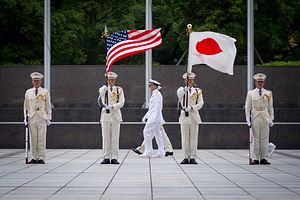The U.S.-Japanese alliance that emerged after World War II was a cornerstone of containment, a central part of the U.S. strategy for waging the Cold War. The occupation of Japan was necessary not only for ensuring that Japan did not return to its militaristic ways, but also out of concern for positioning in competition with the USSR. As an unsinkable aircraft carrier, Japan could limit the ability of the Soviet Navy to sortie into the Pacific. As an economic power, Japan could offer a foundation for the liberal international trade order in Asia. In short, maintaining the U.S.-Japanese alliance was critical to U.S. Cold War strategy.
But what if it hadn’t gone that way?
A recent International Studies Quarterly article by Yasuhiro Izumikawa of Chua University argues that the triangular diplomatic relationship between Tokyo, Moscow, and Washington was more fluid and complex than is commonly understood. The Soviet Union did not take Japanese alignment with the United States as a given. Rather, it tried to drive a wedge between Washington and Tokyo, not an absurd prospect given that a just a few years before Japan and the United States had waged a brutal, ferocious war that had left the greater part of urban Japan in ashes.
The United States responded with “binding strategies.” When faced with an adversary’s attempt to drive a wedge into an alliance, partners can attempt to bind the alliance through rewards and coercion. Rewards included the support of Japanese export penetration into the United States and Southeast Asia, security guarantees that reduced vulnerability without forcing Japan to spend excessively on its defense, and financial assistance. But the USSR also had tools. It held Japanese prisoners of war, could make territorial concessions in disputed island chains, and had not yet signed a full peace treaty with Japan. The possibilities interested Ambassador to the United Kingdom Shunichi Matsumoto and Foreign Minister Mamoru Shigemitsu in negotiations held in 1955 and 1956, but the Soviets requested that Japan sharply curtail U.S. permissions to enter the Sea of Japan, a red line that Washington could not cross.
The United States responded with coercion. Secretary of State John Foster Dulles made clear that if Japan accepted Soviet concession in the Kurils with the attached restrictions on U.S. naval deployments, the United States would assert full sovereignty over Okinawa. This was too much for the Japanese, and negotiations with the Soviets ended without a peace treaty or territorial concessions. At the same time, the United States relaxed pressure on Japan to reconstruct its military more quickly and more comprehensively. This simultaneously had a positive diplomatic impact with the Japanese people, while binding Japanese security more tightly to the U.S. security guarantee.
One lesson of this period is that the United States cannot take anything for granted. Japan’s commitment to the United States was less solid than is commonly understood, even as U.S. forces continued to occupy the country. A breakup of that alliance, even if it wasn’t followed by Japanese alignment with the Soviets, would have transformed the Cold War in Asia, and very possibly have made a deep impression on U.S. domestic politics. But another lesson is that attachments can be sticky. It would have been hard for Japan to shift its alignment, and not just because the United States occupied its territory. The United States, through adroit statecraft, managed to make it even more difficult for the Japanese government to consider a diplomatic realignment.
Perhaps the most important lesson is this: Alliances are about more than arms-length negotiations between strategic actors. The United States should take great care with the idea that it can simply bully allies into compliance with strategic objectives. Even coercive efforts require a great deal of tact and care, conducted by experienced, competent diplomats. To approach alliance politics in any other way courts disaster.

































